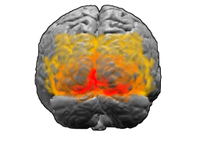
Photo from wikipedia
Our motor behavior can be affected by proprioceptive information. However, little is known about which brain circuits contribute to this process. We have recently revealed that the proprioceptive information arising… Click to show full abstract
Our motor behavior can be affected by proprioceptive information. However, little is known about which brain circuits contribute to this process. We have recently revealed that the proprioceptive information arising from jaw-closing muscle spindles (JCMSs) is conveyed to the supratrigeminal nucleus (Su5) by neurons in the trigeminal mesencephalic nucleus (Me5), then to the caudo-ventromedial edge of ventral posteromedial thalamic nucleus (VPMcvm), and finally to the dorsal part of granular insular cortex rostroventrally adjacent to the rostralmost part of secondary somatosensory cortex (dGIrvs2). Our next question is which brain areas receive the information from the dGIrvs2 for the jaw-movements. To test this issue, we injected an anterograde tracer, biotinylated dextranamine, into the dGIrvs2, and analyzed the resultant distribution profiles of the labeled axon terminals. Anterogradely labeled axons were distributed in the pontomedullary areas (including the Su5) which are known to receive JCMS proprioceptive inputs conveyed directly by the Me5 neurons and to contain premotoneurons projecting to the jaw-closing motoneurons in the trigeminal motor nucleus (Mo5). They were also found in and around the VPMcvm. In contrast, no labeled axonal terminals were detected on the cell bodies of Me5 neurons and motoneurons in the Mo5. These data suggest that jaw-movements, which are evoked by the classically defined jaw-reflex arc originating from the peripheral JCMS proprioceptive information, could also be modulated by the transcortical feedback connections from the dGIrvs2 to the VPMcvm and Su5.
Journal Title: Brain Research
Year Published: 2018
Link to full text (if available)
Share on Social Media: Sign Up to like & get
recommendations!